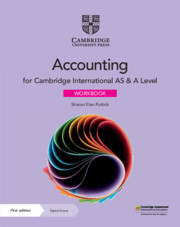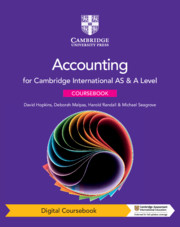Bring new ideas and inspiration into your Cambridge International AS & A Level Accounting classroom with our digital teacher’s resource. Our first edition for AS & A Level Accounting, this resource is filled with step-by-step lesson plans, differentiation and language advice, as well as downloadable materials, such as PowerPoint presentations and worksheets to save you valuable lesson planning time.
Features
- A learning objectives box at the start of every lesson contains learning intentions and success criteria to ensure your lessons remain focussed
- Step-by-step lesson ideas, including group activities, individual tasks and differentiation advice guide your teaching and bring new ideas into your lessons
- Language support for English as a second language learners in every chapter ensures that language level isn’t a blocker to learning
- Downloadable materials, such as PowerPoint presentations and topic worksheets, save lesson-planning time and can be used offline
- Common misconceptions help address student misunderstandings and support every learner
- Your digital teacher’s resource gives you access to everything you need - choose from editable Word files or PDFs to make lesson planning simple
- Access all your Cambridge resources anytime, anywhere and create your own collection in ‘My Resources’
Table of Contents
- Introduction
- About the authors
- How to use this series
- How to use this Teacher's Resource
- Lesson plan template and exemplar
- About the syllabus
- About the examination
- Approaches to teaching and learning
- Teaching notes, supporting materials and answers
- Part I The accounting system
- Chapter 1: Double-entry bookkeeping: Cash transactions
- Chapter 2: Double-entry bookkeeping: Credit transactions
- Chapter 3: The books of prime entry
- Chapter 4: Balancing accounts
- Chapter 5: The classification of accounts and division of the ledger
- Chapter 6: The trial balance
- Part II Financial accounting
- Chapter 7: Statements of profit or loss for sole traders
- Chapter 8: Statements of financial position for sole traders
- Chapter 9: Accounting concepts
- Chapter 10: Accruals and prepayments (the matching concept)
- Chapter 11: Accounting for the depreciation of non-current assets
- Chapter 12: Irrecoverable debts
- Chapter 13: Bank reconciliation statements
- Chapter 14: Control accounts
- Chapter 15: The correction of errors
- Chapter 16: Introduction to incomplete records
- Chapter 17: Incomplete records - further considerations
- Chapter 18: Partnership accounts
- Chapter 19: Partnership changes
- Chapter 20: Manufacturing businesses
- Chapter 21: An introduction to limited company accounts
- Chapter 22: Limited companies – Further considerations
- Chapter 23: Non-profit making organisations (clubs and societies)
- Chapter 24: Statements of cash flows
- Chapter 25: Auditing and stewardship
- Chapter 26: International accounting standards
- Chapter 27: Computerised accounting systems
- Chapter 28: Business acquisition and merger
- Chapter 29: Ethical considerations
- Chapter 30: Accounting information for stakeholders
- Chapter 31: Analysis and communication of accounting information
- Part III: Cost and management accounting
- Chapter 32: Costing of materials and labour
- Chapter 33: Absorption costing
- Chapter 34: Unit, job and batch costing
- Chapter 35: Marginal costing
- Chapter 36: Activity-based costing
- Chapter 37: Budgeting and budgetary control
- Chapter 38: Standard costing
- Chapter 39: Investment appraisal.
Advice on useful tools
Advice on useful tools, activities and timetabling from teachers experiencing school closures.
Cambridge GO
All our supporting resources have now moved to Cambridge GO – the new home for your Cambridge digital content.
Listen to our podcast
Listen to our podcast to discover teaching inspiration & advice from leading educational thinkers.







